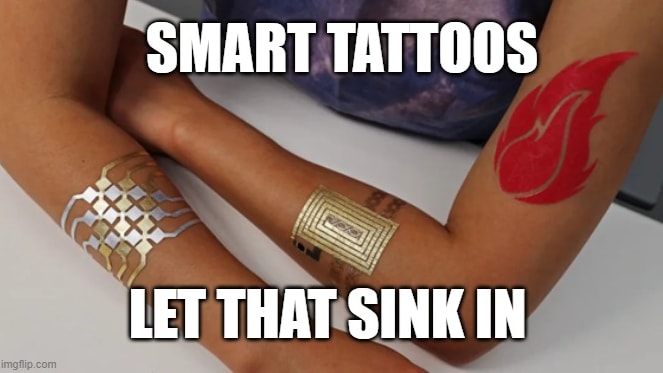Did you ever start driving to work and forget your smartphone at home? Or make a doctor’s appointment just for him to measure your blood pressure and give a prescription? Perhaps you were on a date but realized you’d left your wallet on the study table. Yikes!
No smartphone? Connect with your loved ones through your watch!
Wish to keep a tab on your health? Smart tattoos and fitness trackers got you covered.
No wallet? Pay with a single tap from your smart wristwatch!
Wearable Technology, the unsung hero of our modern era, has stealthily infiltrated fitness, fashion, gaming, and beyond. In a world where even books are smart, wearables stand as a testament to the pervasive influence of the Internet of Things (IoT). The $486.7 billion IoT industry, slated to skyrocket to $566.4 billion by 2027, is set to be propelled by the rise of wearables adorned with embedded IoT sensors.
Enter the TechDogs, provocateurs in the tech realm, sparking debates on whether Iron Man or Batman reigns supreme in the tech-savvy superhero domain. Tony Stark's arsenal boasts 53 suits, linked to JARVIS, enabling flight, laser-shooting, and even outer space voyages. On the flip side,** Batman's** suit reads like a tech lover's dream—telepathic communication, molecular structure manipulation, and space survival.
Drawing parallels to our mortal existence, devoid of Kryptonian genes or magical powers, we find solace in real-world tech. ChatGPT becomes our JARVIS, and smartphones akin to Batman's Sonar Goggles. Yet, before diving into the Batcave of knowledge, the article primes us with a tantalizing glimpse into the futuristic frontier of wearable tech, promising to unravel its origins and potential impact. So, buckle up for a tech-infused journey that transcends the boundaries of fiction and brings wearable wonders to the forefront of our lives!
Please Explain: What Is Wearable Technology?
Wearable Technology, or 'Wearables,' encompasses electronic devices worn to track, analyze, and transmit personal data. Ranging from smartwatches to Google Glass, these IoT devices monitor biometrics and find applications in healthcare, gaming, and fashion. The journey of Wearable Technology extends to the 1500s, now offering a seamless integration of data into our daily lives.
Wearable Technology's journey through time reads like a captivating novel. Starting in the 1500s with German inventor Peter Henlein's necklace watches, it evolved through women's wristwatches in the 1600s **and the introduction of wearable hearing aids in the **1800s. The 1900s **witnessed aviator Alberto Santos-Dumont's pioneering wristwatch use, calculator watches in the **1970s, and MIT's Smart Clothes and smart glass prototypes in the late '90s.
The 2000s **marked Bluetooth headsets' rise, while **2010 **saw Fitbit's step counter debut. The NFC Ring in **2013 **opened doors to advanced wearables, and by **2015, Apple Watch secured smartwatches as modern staples. In the 2020s, the wearable tech landscape continues expanding, hinting at futuristic possibilities like tech-infused tattoos. Presently, nearly 3% of the global population consistently engages with wearables, monitoring everything from oxygen levels to steps, ushering us into a tech-driven era of personalized health tracking.
The question lingers: How does this intricate web of wearables function?
How Does Wearable Technology Work?
Wearable Technology operates as miniaturized marvels, seamlessly blending electronic components into items worn on the body. Equipped with sensors capturing bodily movements, biometrics, and locations, wearables vary in function—from fitness to health and entertainment.
These smart companions employ microprocessors, batteries, and internet connectivity to collect real-time data, syncable with mobile devices. Utilizing IoT-based sensors and accelerometers, wearables monitor everything from motion to heart rate. Uniting them all is the ability to streamline data to the cloud or mobile devices, unveiling a dynamic convergence of technology seamlessly integrated into our daily lives.
Wearable Technology unfolds as a diverse array of tech-infused armor for everyday living:
Smart Watches: Beyond timekeeping, they deliver notifications on calls, messages, and social media updates.
Fitness Tracker: Monitors steps, heart rate, and calculates precise data on calorie burn and exercise.
Head Mounted Display: Immerses users in virtual reality, equipped with augmented and virtual reality features.
Sports Watches: Tailored for athletes, with GPS trackers recording pace, heart rate, and more.
Smart Jewelry: Blending functionality with fashion, notifying users of messages and calls.
Smart Clothing: Fashion meets technology, integrating electronic devices for a stylish appearance.
Implantable Devices: Surgically implanted for medical purposes, tracking contraception, insulin levels, etc.
Smart Tattoos: Replacing traditional ink, these tattoos respond to external stimuli, offering functionalities like monitoring blood sugar, kidney or liver functions, and alerting athletes to dehydration. Wearable Technology, a marvel of innovation, transcends utility, seamlessly integrating tech into our daily lives.
We would love to hear your thoughts on this in the comments below! Till then, we will quickly jump into the benefits this technology holds. Read on!





















